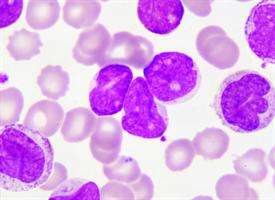As leukemia evolves, stem cells hold keys to newer therapies

A recent study by University of Rochester Medical Center researchers proves why leukemia is so difficult to treat and suggests that the current approach to drug development should be adjusted to target a broader range of genes or signaling pathways.
Lead author Michael Becker, M.D., associate professor of Medicine, Hematology/Oncology at the UR's Wilmot Cancer Institute, explains that some of the new drugs for acute leukemia attack very specific proteins expressed by leukemia cells. But Becker's study breaks new ground by showing that as the disease progresses, leukemia stem cells (the root of the disease) change and often begin expressing additional proteins that weren't present when the cancer first occurred or lose protein expression when the cancer relapses.
His investigation, published in the journal Blood, is believed to be the first to examine how leukemia stem cells change over time, and the first to look for several known gene biomarkers simultaneously.
"It's a wake-up call for future therapy development," said Becker, who also directs Wilmot's Blood and Marrow Transplantation (BMT) Program, one of the largest in New York. "Over the last several years a lot of effort has been placed on the development of a few drugs that target proteins such as CD33, CD123, and CD47 on acute leukemia cells. The next generation of immunotherapies also targets very specific proteins. But to achieve long-term remissions and cures, our findings argue against this approach."
Acute myeloid leukemia (AML) is the most difficult blood malignancy to treat and has a dismal prognosis if the disease comes back after initial therapy, as it often does.
Back in the mid-1990s, scientists identified a rare subset of leukemia stem cells (LSC) associated with acute leukemia. Knowing that these stem cells existed helped researchers understand why leukemia is not easily killed by chemotherapy. LSCs, they discovered, have different properties than other cancer cells and normal cells, and can lay dormant for long periods. Leukemia stem cells also can behave differently in each patient.
But few scientists have used leukemia cells from patients to closely study the changes that take place at various time points in the disease. Wilmot researchers have been collecting LSC samples from patients at diagnosis, during treatment, and again if the disease relapses. Investigators analyze the samples using a method that involves isolating stem cell populations. Then they watch for changes among the many protein biomarkers and for signs that the numbers of leukemia stem cells are expanding.
The newly published data from 25 patients show a previously unreported nine to 90-fold increase in the pool of LSCs between diagnosis and relapse. With proof of the expanded pool of stem cells, which are resistant to therapy, scientists have a better understanding of why so few patients survive after the disease comes back, Becker said.
"Our work suggests that we might be able to reduce the numbers of leukemia stem cells by looking at the pathways responsible for stem cell expansion," he said.
For AML patients, the study underlines the importance of receiving therapy that has the highest likelihood of achieving long-term remission on the first attempt, Becker said. The next step in research is to identify drugs that allow patients to remain in remission.
More information: T.-C. Ho et al. Evolution of acute myelogenous leukemia stem cell properties following treatment and progression, Blood (2016). DOI: 10.1182/blood-2016-02-695312


















